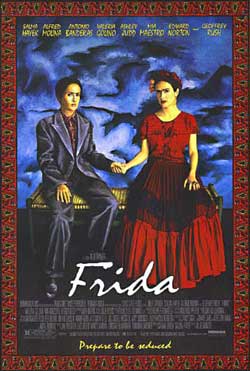 Were Diego Rivera and Frida Kahlo the Ralph and Alice Kramden of 20th-century Mexican art? A hard nut to swallow, but that’s what Julie Taymor’s Frida would have us believe. On one level, the movie is yet another tiresome invocation of artistic bohemia (art, sex! booze! infidelity! nudity! sex! sex! sex! sex!) meant to titillate the middle class, while delivering enough lectures on suffering to make it seem righteous (cf, Moulin Rouge, Basquiat, etc.).
Were Diego Rivera and Frida Kahlo the Ralph and Alice Kramden of 20th-century Mexican art? A hard nut to swallow, but that’s what Julie Taymor’s Frida would have us believe. On one level, the movie is yet another tiresome invocation of artistic bohemia (art, sex! booze! infidelity! nudity! sex! sex! sex! sex!) meant to titillate the middle class, while delivering enough lectures on suffering to make it seem righteous (cf, Moulin Rouge, Basquiat, etc.).
But Taymor seems utterly indifferent to both Kahlo and her milieu, fumbling the artist’s actual accomplishments and the details of her environment. You would never know, for example, that at the time Kahlo met Rivera, Mexico City was home to a thriving colony of native and foreign artists. Nor would you know what a hot topic revolutionary politics were at the time, as Taymor limits politics pretty much to a drunken conversation, the famous mural controversy between Rivera and Nelson Rockefeller, and a pity lay Kahlo bestows on Leon Trotsky. The photographer and former actress Tina Modotti, for example, is passed off mostly as a lesbian conquest of Kahlo’s, not as a former suspect in a political assassination, a spy, or even a Communist figure in a mural she posed for with Kahlo (and which we see Kahlo pose for in the movie; did Taymor not know about Modotti’s participation?)
Of course, all this would get in the way of the depiction of Kahlo as Rivera’s ardent spouse. It’s true that Rivera and Kahlo had bizarrely strong ties, particularly in the face of the mural-painter’s compulsive womanizing. But bizarre is the word; you only have to look at Kahlo’s paintings to realize that she had a neurotic personality. But Taymor seems afraid to approach the question of either her or Rivera’s probable neuroses, as if somehow that will call into question their greatness as artists. Following conventional wisdom, Taymor lays off all the bloody masochism apparent in Kahlo’s work onto the bus accident she suffered early in her life, when her legs were smashed and a pole entered her back and exited her vagina. The champions of this theory never address the artistic stasis this single preoccupation would entail, but, like Van Gogh’s ear, it does give a certain type of observer a comfortable perspective.
So their just a couple of hotheads, a la Ralph and Alice, the bus driver and housewife of Jackie Gleason’s famous sitcom, "The Honeymooners." They may fight, they may lose their tempers, but in the end, they have to say, "Baby, you’re the greatest."
This reduction of Kahlo to a long-suffering helpmate is occasionally accompanied by gaudy, but ultimately banal attempts to copy some of the artist’s paintings, or painterly techniques, through trompe l’oeil effects or elements of production design. There are also three animated or semi-animated segues, including one done by the Brothers Quay, meant to portray the troubled consciousness of what’s supposed to be a suffering complex figure. In between these strenuous visual efforts, the film’s compositions don’t arise above the utilitarian. In other words, Taymor’s visual contributions are ornamental and decorative, not expressive.
The casting is all of piece with this. Salma Hayek’s Frida is quite a sexpot, particularly in the lesbian scenes, where she’s all languor and seduction. As for her suffering, you have to take her word for it, because it never impinges on her daily life, unless a scene specifically calls for it. It’s just a dramatic device, not an inherent part of her character. For that matter, the same could be said of her painting. Kahlo the painter hardly ever appears here.
Rivera the muralist certainly is here. He’s everywhere in fact. Alfred Molina’s coincidental resemblance to Jackie Gleason, as well as his impression that Rivera must have bellowed all the time, makes him Taymor’s co-conspirator in pushing Rivera to the center of the screen. Not that we get to know Rivera any better than we do Kahlo; he’s just the bigger hole.
Most of the rest of the parts follow a pattern of celebrity casting: Oscar-winner Geoffrey Rush plays Leon Trotsky, everyone’s favorite Communist; Edward Norton is Nelson Rockefeller; and Antonio Banderas plays David Siqueiros while Tina Modotti is impersonated by Ashley Judd. The last two roles, as written if not as played, are likely to rile up admirers of these two artists.
Finally, a word on the screenwriters. There are four listed, the last two, meaning the latest to work on the script, being the team of Gregory Nava and Anna Thomas. These two wrote, and Nava directed, the stupefyingly condescending El Norte as well as La Familia, which lifted its entire ending, virtually shot-by-shot, from Satyajit Ray’s The World of Apu. It’s not terribly surprising to see their names on a work like Frida. At the top of the list is the name Clancy Sigal, whose position means nothing of what he wrote probably remains. Too bad; over the years he’s demonstrated both the political and artistic savvy worthy of a go at the life of Frida Kahlo. I recommend highly that you try and get a hold of a great book he wrote, Weekend in Dinlock, a tale of an American writer and a young miner from the north of England.
